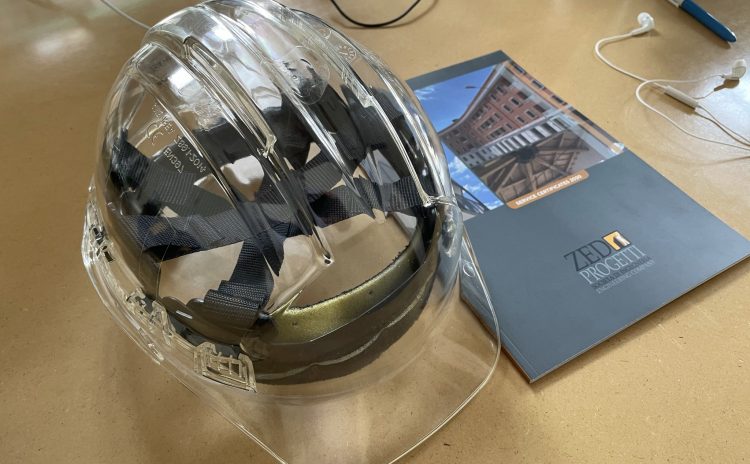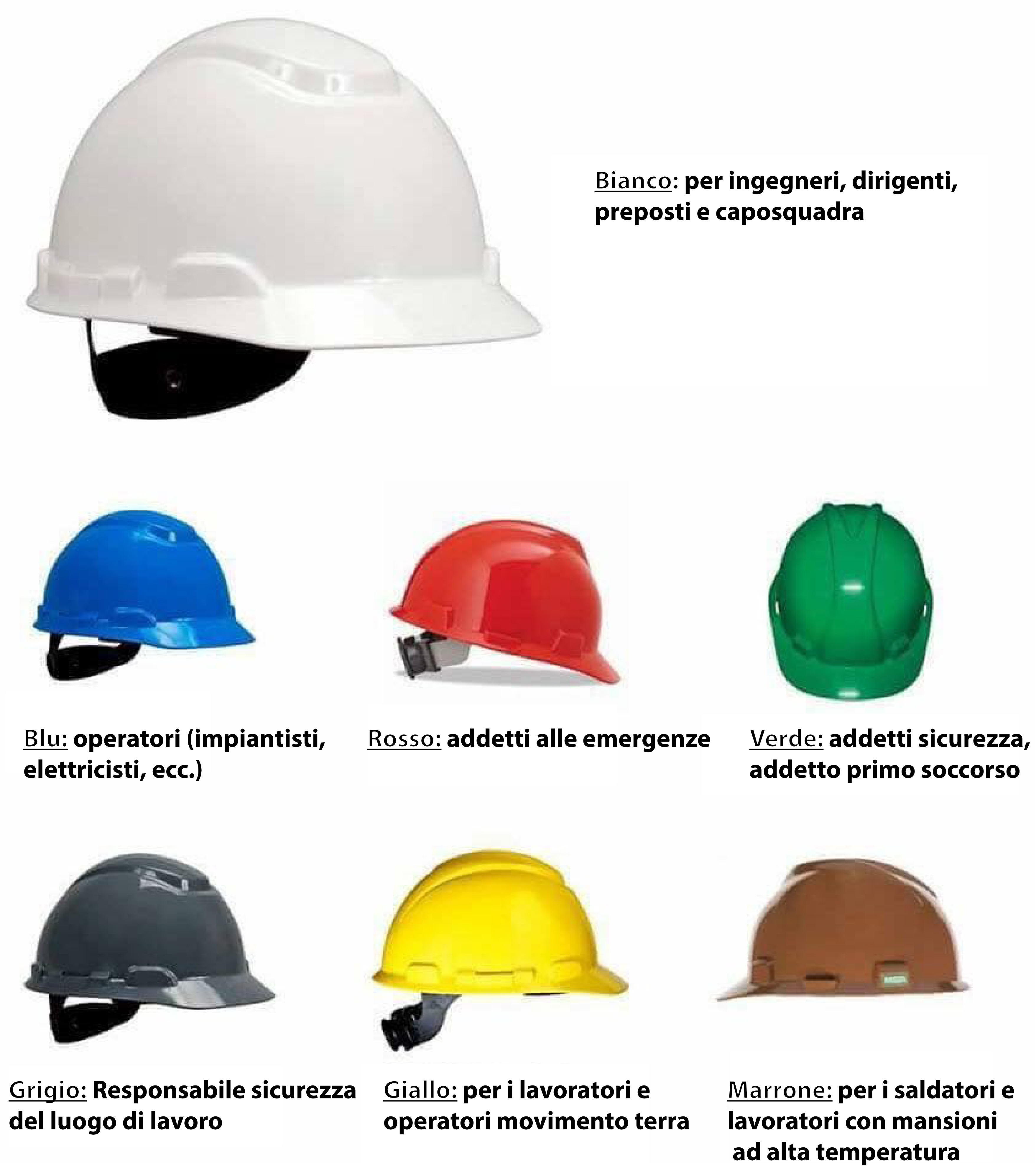IL SIGNIFICATO DEI COLORI DEI CASCHETTI DI PROTEZIONE
The meaning of colours for protective helmets
- 22 Gen 2024

L’Allegato VIII del D. Lgs. 81/2008 riporta un elenco indicativo e non esauriente di Dispositivi di Protezione Individuali (DPI) e in relazione alla protezione del capo indica che i lavoratori esposti a specifici pericoli di offesa al capo per caduta di materiali dall’alto o per contatti con elementi comunque pericolosi devono essere provvisti di copricapo appropriato. Parimenti devono essere provvisti di adatti copricapo i lavoratori che devono permanere, senza altra protezione, sotto l’azione prolungata dei raggi del sole.
Gli elmetti ed i caschi sono copricapi a coppa, generalmente di materiale plastico resistente (policarbonato termoplastico) o rinforzato (fibra di vetro) o metallico (alluminio o altra lega leggera) usati come protezione della testa dall’impatto e dalla caduta di oggetti.
Sono destinati a proteggere le zone parietali, la sommità del capo e la nuca, quindi la parte della testa compresa al di sopra di un piano orizzontale di riferimento (basic-plane) delimitato dalle linee congiungenti la sommità del condotto uditivo esterno con il bordo inferiore dell’orbita.
Il grado di protezione che possono offrire caschi ed elmetti è condizionato, da una parte, dai limiti fisiologici di tollerabilità della sollecitazione d’urto, dall’altra da difficoltà di ordine tecnico connesse alla realizzazione di un mezzo che deve, nello stesso tempo, possedere una adeguata resistenza meccanica, una elevata capacità ammortizzante ed un peso non elevato.
Le principali caratteristiche che caschi ed elmetti devono possedere sono:
1) assorbimento agli urti
2) resistenza alla perforazione
3) resistenza alla pioggia ed alla luce solare
4) ininfiammabilità
5) proprietà dielettriche (tensione di perforazione non inferiore a 10 kV).
Le norme su tale dpi sono:
Norma EN 397: Elmetto di protezione per le industrie
La norma EN397, relativa agli “elmetti di protezione per le industrie”, esige quanto segue per la marcatura: Ogni elmetto deve avere un marchio stampato o impresso che riporti le seguente indicazioni:
- il numero della presente norma europea,
- il nome o la marca del fabbricante,
- l’anno e il trimestre di fabbricazione,
- il tipo di elmetto
- la taglia o la scala taglie
Indicazioni complementari, quali le istruzioni o raccomandazioni di regolazione, di montaggio, di uso, di lavaggio, di disinfezione, di manutenzione e di stoccaggio, sono specificate nel foglietto di utilizzo.
Norma EN 812: Casco antiurto
La norma EN812 concerne i caschi anti-urto usati correntemente nell’industria, per proteggere la testa quando si urta con oggetti duri che possono provocare delle lacerazioni o altre ferite superficiali alla persona che lo indossa o stordirla. Sono prevalentemente destinati a degli utilizzatori che lavorano in interni.
Un casco antiurto non protegge dagli effetti della caduta di oggetti e non deve in nessun caso sostituire un elmetto di protezione per l’industria regolato dalla norma EN397.
Se il Legislatore ne ha previsto l’ uso, va però detto che non esiste una legge per regolamentare e stabilire quali debbano essere i colori da utilizzare per gli elmetti di protezione. Infatti, in un cantiere è possibile indossare secondo la normativa vigente elmetti di qualunque colore. La legge non stabilisce i ruoli suddivisi in base al colore degli elmetti, poiché si orienta in maniera differente.
Per scoprire che la reale natura e destinazione dei colori degli elmetti di protezione nei cantieri edili può essere individuata all’interno del dettato normativo previsto dall’articolo 18 comma 1, lettera d), D.Lgs 81/08 e s.m.i. sancisce infatti che, il datore di lavoro deve fornire ai lavoratori i necessari e idonei dispositivi di protezione individuale, sentito il responsabile del servizio di prevenzione e protezione e il medico competente, ove presente.
E’ la normativa di legge, oltre che la consuetudine, che consiglia allo stesso datore di lavoro di stabilire che tipo di colore deve avere il casco, in riferimento sia alle singole posizioni funzionali dei propri dipendenti, sia al luogo dove operano.
Al di fuori dell’ambiente ristretto dei soli cantieri edili, è comunque presente un sistema di sicurezza, previsto dal decreto ministeriale 442 del 13 luglio 1990, sui colori degli elmetti di protezione da utilizzare per lavori sotto tensione effettuati su impianti elettrici. Secondo questo regolamento si evince molto chiaramente come sui cantieri il personale si distingua per il seguente colore degli elmetti di protezione: Preposto ai lavori, CASCO ROSSO; Operatore abilitato, CASCO GIALLO; Personale ausiliario, CASCO BIANCO.
In ogni caso per quanto riguarda i dispositivi di protezione individuale della testa, le linee guida ci ricordano come nell’allegato VIII del D.Lgs. 81/2008 siano indicati alcuni criteri di sicurezza e prestazionali importanti nella scelta degli elmetti di protezione più idonei e sono indicati i rischi derivanti dall’utilizzo degli elmetti di protezione e i conseguenti fattori di cui tener conto nella scelta dei dispositivi di protezione individuale per la testa.
Al di là di quelle che possono essere le decisioni del datore di lavoro rispetto alla scelta dei caschi di protezione da utilizzare, c’è da dire che in generale c’è una regola non scritta per cui gli elmetti possono essere suddivisi per colori e indicare specifici ruoli all’interno del cantiere:
- l’elmetto bianco per ingegneri, architetti, dirigenti, preposti e caposquadra
- quello blu è solitamente lasciato ali operatori impiantisti
- l’elmetto rosso serve per identificare l’addetto alle emergenze;
- quello verde alle pratiche di pronto soccorso nel luogo di lavoro;
- per l’utilizzo dell’elmetto grigio, solitamente identifica i RSPP (Responsabili Sicurezza sui luoghi di lavoro)
- quello giallo va ad identificare gli operai generici
- il marrone è per i saldatori ed i lavoratori per lavorazioni ad alta temperatura.
- A prescindere dai colori che vengono usati abitualmente, a volte gli elmetti rossi per esempio, vengono utilizzati anche per coloro che gestiscono delle emergenze in precisi momenti.

 Arch. Anselmo Santilli- ZED PROGETTI srl
Arch. Anselmo Santilli- ZED PROGETTI srl
Annex VIII of Legislative Decree 81/2008 contains an indicative and non-exhaustive list of Individual Protection Devices (PPE) and in relation to head protection indicates that workers exposed to specific dangers of head injuries due to falling materials or contact with dangerous elements must be provided with appropriate headgear. Similarly, workers who have to remain under prolonged exposure to the sun’s rays without other protection must be provided with suitable headgear.
Hard hats and helmets are cupped headgear, generally made of tough plastic (thermoplastic polycarbonate) or reinforced (glass fibre) or metal (aluminium or other light alloy) material, used to protect the head from impact and falling objects.
They are intended to protect the parietal areas, the top of the head and the nape of the neck, i.e. the part of the head above a horizontal reference plane (basic-plane) delimited by the lines joining the top of the external auditory canal with the lower edge of the orbit.
The degree of protection offered by helmets and helmets is conditioned, on the one hand, by the physiological limits of tolerability of the impact stress, and on the other by technical difficulties connected to the creation of a means that must, at the same time, have adequate mechanical resistance, a high cushioning capacity and a low weight.
The main characteristics that helmets and helmet-helmets must possess are:1) shock absorption
2) puncture resistance
3) Resistance to rain and sunlight
4) Non-flammability
5) Dielectric properties (perforation voltage not less than 10 kV).The standards for such elements are:
Standard EN 397: Industrial safety helmet
Standard EN397, on “industrial safety helmets”, requires the following for marking: Each helmet must have a printed or embossed mark giving the following information:the number of this European standard,
the name or brand of the manufacturer
the year and quarter of manufacture,
the type of helmet
the size or size scale
Additional information, such as instructions or recommendations for adjustment, fitting, use, washing, disinfection, maintenance and storage, is specified in the leaflet.Standard EN 812: Impact helmet
Standard EN812 covers crash helmets commonly used in industry to protect the head when striking hard objects that may cause lacerations or other superficial injuries to the wearer or stun him. They are mainly intended for users working indoors.
A crash helmet does not protect against the effects of falling objects and should in no case replace an industrial safety helmet regulated by standard EN397.Although the legislator has provided for their use, it must be said that there is no law to regulate and establish what colours should be used for protective helmets. In fact, it is possible to wear helmets of any colour on a building site, according to current legislation. The law does not stipulate roles according to the colour of helmets, as it is oriented differently.
To find out that the real nature and destination of the colours of hard hats in construction sites can be identified within the normative dictate of Article 18 paragraph 1, letter d), Legislative Decree 81/08 and subsequent amendments and additions states that, in fact, the employer must provide workers with the necessary and suitable individual protection devices, after consulting the person in charge of the prevention and protection service and the competent doctor, if any.
It is the law, as well as custom, that advises the employer to determine what colour helmet should be, with reference to both the individual functional positions of his employees and the place where they work.
Outside the restricted environment of construction sites only, there is however a safety system, provided for by Ministerial Decree 442 of 13 July 1990, on the colours of protective helmets to be used for live work on electrical installations. According to this regulation, it is very clear that on construction sites, personnel are distinguished by the following colours of their protective helmets: Work supervisor, RED HELMET; Qualified operator, YELLOW HELMET; Auxiliary personnel, WHITE HELMET.
In any case, with regard to individual head protection devices, the guidelines remind us that Annex VIII of Legislative Decree 81/2008 sets out some important safety and performance criteria for choosing the most suitable protective helmets and indicates the risks arising from the use of protective helmets and the consequent factors to be taken into account when choosing individual head protection devices.
Apart from what may be the employer’s decisions regarding the choice of protective helmets to be used, it must be said that in general there is an unwritten rule that helmets can be divided by colour and indicate specific roles within the worksite:
– the white helmet for engineers, architects, managers, supervisors and team leaders
– the blue one is usually left for plant operators
– the red helmet is used to identify the emergency worker;
– the green helmet for first aid in the workplace;
– the grey helmet is usually used to identify RSPP (workplace safety managers)
– the yellow one identifies general workers
– brown is for welders and workers working at high temperatures.
– Regardless of the colours that are usually used, sometimes red helmets are also used for those who manage emergencies at specific times.

